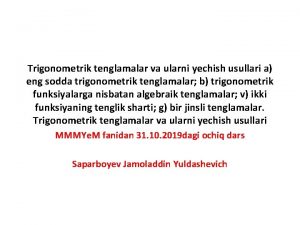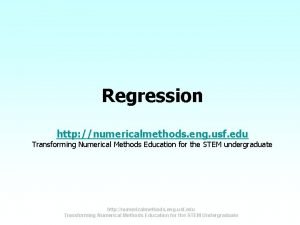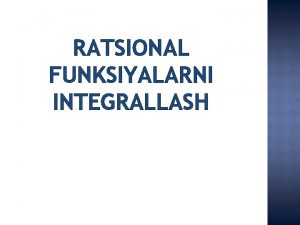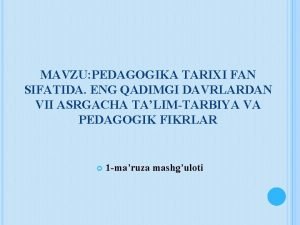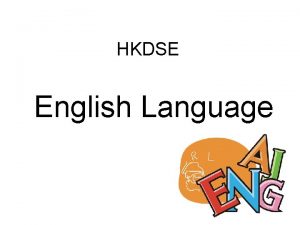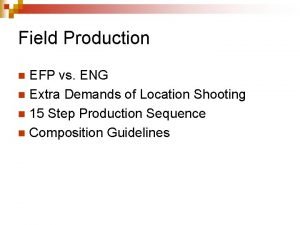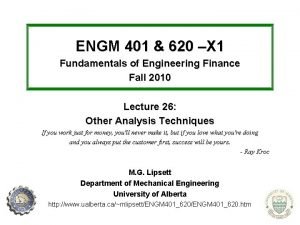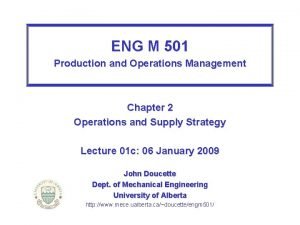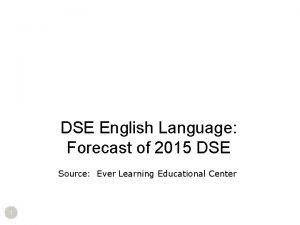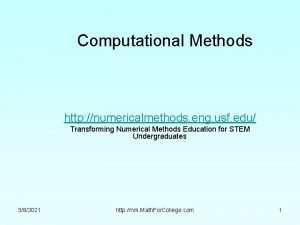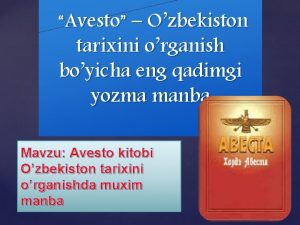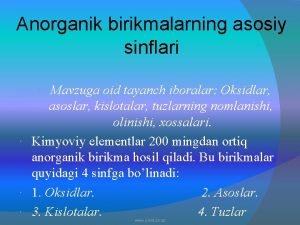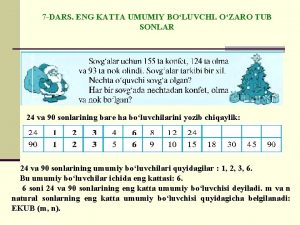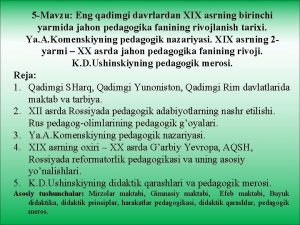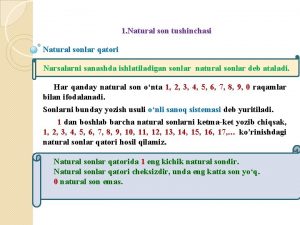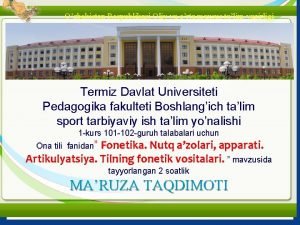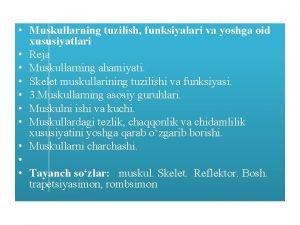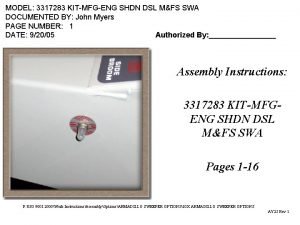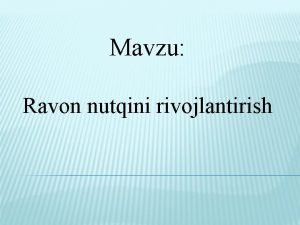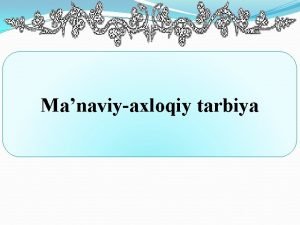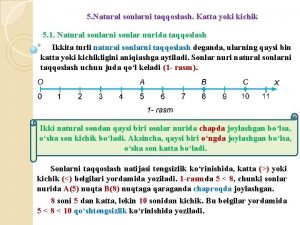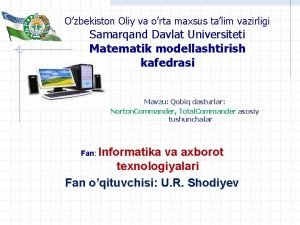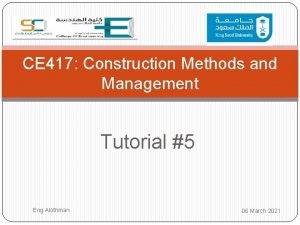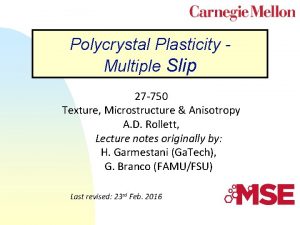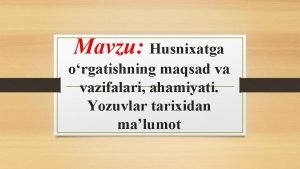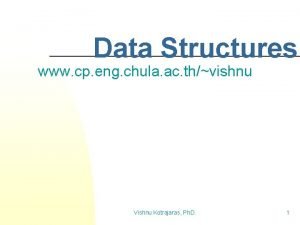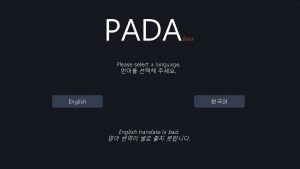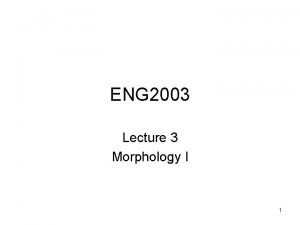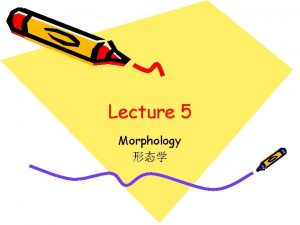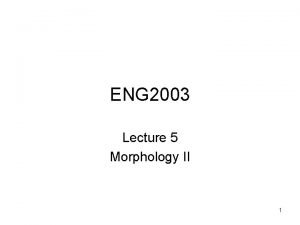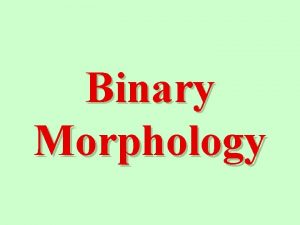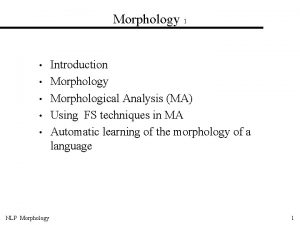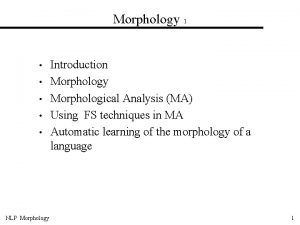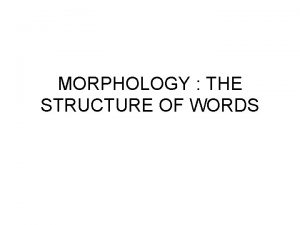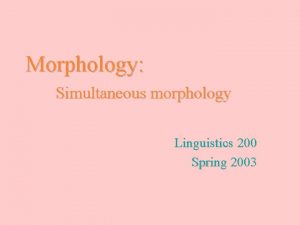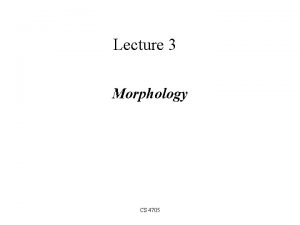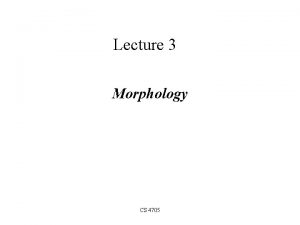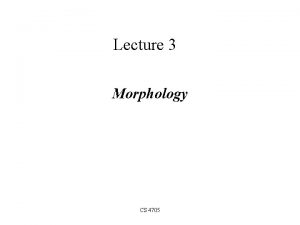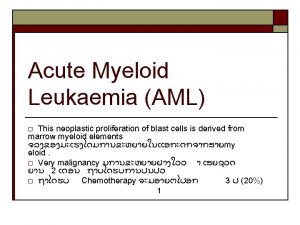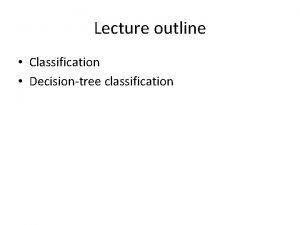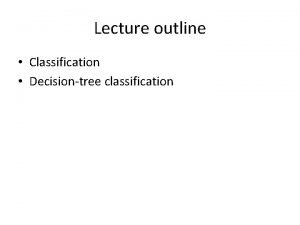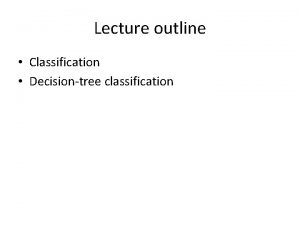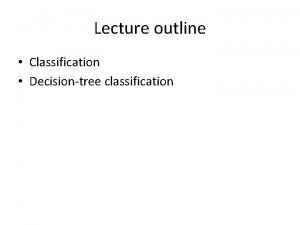ENG 2003 Lecture 5 Morphology II 1 Classification















































- Slides: 47

ENG 2003 Lecture 5 Morphology II 1

Classification of Affixes • Another way to divide affixes is into derivational or inflectional. • Derivational morphology tends to be noncompositional (meaning cannot be easily deduced from the parts) • Inflectional morphology tends to be compositional (meaning is easily deduced). 2

Classification of Affixes cat-s plural of cat Plural morpheme is fully compositional. penniless penny-less very poor – not just lack of pennies /-less/ morpheme is less compositional. 3

Classification of Affixes • Adding a derivational morpheme tends to create a “new word” – penniless is listed separately in the dictionary • Adding an inflectional morpheme isn’t usually considered making a “new word” – cats is not listed separately from cat in the dictionary • Rule of thumb!!! Many grey areas!!! 4

Derivational - Inflectional • Derivational affixes form words that differ from the base in meaning and/or function. • Example: ‘un’ creates the opposite meaning of ‘happy’ • Inflectional affixes typically indicate syntactic properties or relations • Example: they may indicate agreement between subject and verb : he eats • They may indicate tense: 갔다 ka-ass-ta go-PST-DECL ‘went’ 5

DERIVATIONAL AFFIXES • Derivational affixes may change the lexical category of a word – penny is a noun – penniless is an adjective • Inflectional affixes never change the lexical category – Both cat and cats are nouns 6

DERIVATIONAL AFFIXES ‘judge’ category: verb meaning: to decide questions of law, to estimate verb root judge + derivational suffix -ment derivation: ‘judgement’ category: noun new meaning: an opinion or fact-based decision 7

DERIVATIONAL AFFIXES verb root act + derivational suffix -er Derivation: ‘actor’ category: noun meaning: performer in a theatrical sense • NB: ‘or’ and ‘er’ are alternate spellings of the same morpheme 8

DERIVATIONAL AFFIXES ‘act’ category: verb meaning: perform, produce an effect verb root act + derivational suffix -ive Derivation: ‘active’ category: adjective meaning: energetic, busy 9

DERIVATIONAL AFFIXES Deriv. prefix in- + adjective base active Derivation: ‘inactive’ category: adjective meaning: inert, not active, lazy (opposite of active) 10

DERIVATIONAL AFFIXES adjective base active + derivational suffix -ate Derivation: ‘activate’ category: verb meaning: put into service or motion derivational prefix de- + verb base activate Derivation: ‘deactivate’ category: verb meaning: put of service, render inactive (reverse of ‘activate’) 11

Derivational Affixes verb base deactivate + deriv. suffix -ion Derivation: ‘deactivation’ category: noun meaning: the act of putting out of service or motion 12

Tree for derivation of ‘deactivation’ 13

DERIVATIONAL AFFIXES • English has a very rich derivational morphology, with many derivational prefixes and suffixes -able V Adj fixable understandable doable readable *cryable/criable (from cry) *sneezable *goable *diable (from die) -ize N or Adj V hospitalize, crystalize, modernize, nationalize de- V V de-activate, demystify, denationalize 14

DERIVATIONAL AFFIXES • English has a very rich derivational morphology, with many derivational prefixes and suffixes -able turns verbs into adjectives ‘able to undergo action denoted by verb’ -ize turns nouns or adjectives into verbs ‘to make or become state denoted by root. de- turns verbs into verbs ‘to reverse action denoted by verb’ 15

DERIVATIONAL AFFIXES • There can be more than one derivational affix in a word • Words may seem to be derived in layers • The placement and ordering of derivational affixes is dictated by the rules of morphology • Thus, ‘usefulness’ but not ‘*usenessful’ 16

PRODUCTIVITY OF DERIVATIONAL AFFIXES • Derivational affixes vary in their degree of productivity • This is the freedom with which speakers use them to create new words Particularly productive affixes are: ‘able’ that turns verbs into adjectives: ‘acceptable’ and ‘adaptable’ ‘er’ that turns verbs into nouns: ‘hunter’ ‘reader’ and 17

PRODUCTIVITY OF DERIVATIONAL AFFIXES Less productive affixes are: ‘en’ of ‘thicken’ and ‘darken’ ‘th’ of ‘warmth’ but not ‘*thinnen’ and ‘*coolth’ • However, ‘coolness’ can be derived with the productive suffix ‘ness’ • The derivational prefix ‘de’ is currently quite productive: • ‘deplane’ ‘defuse’ ‘demystify’ ‘debug’ ‘dethrone’ ‘debunk’ ‘deintensify’ ‘defriend’ 18

PRODUCTIVITY OF DERIVATIONAL AFFIXES Note the varying degrees of productivity of the following derivational affixes: -ism idealism, realism, sadism, but not *nastism -ity sanity, vanity, practicality, scarcity, nicety but not *nastity -ness meanness, goodness, usefulness, nastiness ‘-ness’ is more productive ‘-ity’ is less productive ‘-ism’ tends to change the meaning of the root in unexpected ways as in ‘belief systems’ 19

OPEN AND CLOSED CLASS ITEMS IN THE LEXICON Open class items include the lexical categories: nouns, verbs, and adjectives • carry main semantic content Closed class items include pronouns, prepositions, articles, conjunctions and other functional morphemes • Affixes are also considered closed class morphemes 20

OPEN AND CLOSED CLASS ITEMS IN THE LEXICON • Open class items far outweigh the number of closed class items • Some aphasics (people with language impairments due to brain damage) show differential impairment of closed and open class lexical items • Suggests they are processed differently in the brain 21

COMPOUNDING Compounding – combining two or more free, usually open class, morphemes to create a new word • The meaning of a compound may not be directly discernible from the meanings of the individual morphemes Examples: • ‘pancake’ • ‘hotdog’ • ‘baseball’ • ‘mother-in-law’ 22

Compounding English compounds have one word-level stress. adjective noun: hót dóg (two lexical words – each has one stress) compound noun: hótdog (treated as one word for stress assignment) blúe hóuse (a house that is blue) the Blúehouse (presidential residence of South Korea) Korean has two strategies for marking compounds 나뭇가지, 횟집, 김밥 use ㅅ to join compounds – ㅯ not possible in modern Hangeul 깻잎, 사랑니, 부억일 use ㄴ to join compounds if second component begins with [i] (may or may not be reflected in orthography) 23

Compounding • In Korean and English compounds, the rightmost morpheme or head determines the category of the compound • There are many possible combinations of compounds in English • For example (heads are in blue): • adjective + noun = ‘hotdog’ (noun) • noun + verb = steamroll (verb) 24

25

Identifying Compounds • • • Stress test Adjective plus noun: hót dóg compound noun: hótdog Inflection test Inflections are normally added at the end of entire compound • He dropkicked the ball not: *He droppedkick the ball. Some exceptions related to semantic issues: mothers-in-law *%mother-in-laws 26

Endocentric and Exocentric Compounds • Endocentric: the compound denotes a subtype of the concept denoted by the head • ‘fireman’ = type of man • Exocentric: the meaning of the compound is not easy to figure out from its parts • ‘redneck’ is not a type of neck 27

Endocentric and Exocentric Compounds • English endocentric compounds whose heads have irregular plurals also pluralize irregularly • tooth- teeth • wisdom tooth – wisdom teeth • English exocentric compounds whose heads have irregular plurals use regular plurals • leaf – leaves • Maple Leafs • I saw some saber-tooths/bigfoots at the zoo yesterday. 28

Dvandva Compounds • If both components of the compound carry equal weight in determining the head of the compound, we call it a dvandva compound. • Term is borrowed from Sanskrit, which contains many examples. Boznia-Herzegovina singer-songwriter Mandarin: a mother-daughter relationship Sino-Tibetan (a language family) shān-chuān mountain-river ‘mountains and rivers’ dvandva diàn-na o electric-brain ‘computer’ exocentric 29

Practice Caution: N -ate-ion vs. -ation attaches to verbs derived with -ize colonize mechanize colonization mechanization *colonizate * mechanizate V V BUT Af N decolony decolonization Af Af apply applicate application fabricate fabrication -ize -ation orient %orientate orientation converse % conversate conversation 30

Practice Adj Adj Af V V Af untie -able untieable = not tieable, not able to be tied Af V Af untie -able untieable = able to be untied 31

Practice N Adj Af V Af uncombine -able uncombinability Af -ity 32

Practice mechanize mechanical N V /mechan/ is a bound root V Af Root Af demechan -ize demechanization Af -ation 33

Practice Adv Adj operate operable opera Adj V /oper/ is a bound root V Af Af Root Af Af Af uncooperatively -ate -ive -ly 34

Practice N N N Adj N N fast food restaurant chain N chain 35

Practice N N V N N N Adj steel knife sharpener Af Af -en -er 36

Practice N N N V N N Adj steel knife sharpener Af Af -en -er 37

INFLECTIONAL AFFIXES • Inflectional morphemes indicate purely grammatical relationships. • They do not change the core meaning of the word. • Inflectional morphemes typically appear outside of derivational morphemes. 38

Languages may inflect for: • noun class: (gender, animacy, etc. ) • number: singular, dual, plural, etc. • person: 1 st, 2 nd, 3 rd, obviative, inclusive, exclusive • case: nominative, accusative, dative, ergative… • tense: past/present (future is often different) • aspect: progressive, perfect, habitual, etc. • evidentiality: hearsay, reliable source • definiteness and specificity • comparative/superlative • etc. 39

Noun Class In many Indo-European languages, nouns are inflected for gender. Inflection often shows up on object agreement and on determiners. French la pomme vert-e the. FEM apple green-FEM ‘the green apple’ German der Mann the. MASC man le crayon vert-Ø the. MASC pencil green-MASC ‘the green pencil’ die Frau the. FEM woman das Kind the. NEUT child The noun itself may have a noun class marker attached to a root. Spanish amig-o friend-MASC ‘male friend’ amig-a friend-FEM ‘female friend’ 40

Noun Class Not all languages mark noun class with gender. Animacy is a common basis for noun classes. Cree si: p duck ‘duck’ si: p-ak duck-PL. ANIM ‘ducks’ astotin cap ‘cap’ astotin-a cap-PL. INANIM ‘caps’ ANIM = animate; INANIM = inanimate Noun classes are subject to arbitrary divisions: French: door and table are feminine (la porte, la table), while sun and tap are masculine (le sol, le robinet) Cree: sock is animate (asikan-ak), shoe is inanimate (maskisin-a) German: girl is neuter (das Mädchen) 41

Noun Class Some languages have a large number of noun classes which are marked by the use of classifiers. 사과 네 개 sakwa ney apple four ‘four apples’ Mandarin sān ben three CL ‘three books’ shì zhī ten CL ‘ten dogs’ shū book gǒu dog kay CL 학생 두 명 haksayng twu student two ‘two students’ myeng CL ‘ben’ is used for printed material ‘zhī’ is used for animals and single items of a pair 42

Number Languages make use of the following number distinctions: singular – one entity dual – two entities trial – three entities plural – several entities (depends on other number categories present) paucal – a small number of entities In a language that has dual, but not trial or paucal, plural means “three or more”. In modern English, which has neither dual, trial or paucal, plural means “two or more” Note: English has ‘both’, thus ‘all’ is typically reserved for groups of three or more. 43

Number • Old English had a dual inflection for two of something • Below are some examples of Old English pronouns 44

Person Languages make use of the following person distinctions: 1 st – includes the speaker 2 nd – includes the hearer 3 rd – includes neither the speaker nor the hearer Consider the following sentence: We’re going to the movies tonight… …what would you like to see? [Oh, good, I’m invited. ] …can you look after the dog? [Oh, darn, I’m not invited. ] We = 1 st person plural = speaker + others may or may not include listener 45

Person Some languages have an inclusive-exclusive distinction. 1 st person plural inclusive – includes listener 1 st person plural exclusive – excludes listener Consider the following paradigm from Onondaga (Iroquoian) hgęhaˀ yagnigęhaˀ yagwagęhaˀ I see it. We two see it. – excl. We all see it. – excl. sgęhaˀ snigęhaˀ swagęhaˀ You see it. You two see it. You all see it. hagęhaˀ yegęhaˀ He sees it. She sees it. Someone sees it They(f) two see it. They(f) all see it. gnigęhaˀ gǫdigęhaˀ dnigęhaˀ dwagęhaˀ You and I see it. You all and I see it. hnigęhaˀ hadigęhaˀ They(m) two see it. They(m) all see it. 46

Allomorphy Consider the following Korean data. sakwa nakci poto chayk pap sikan Nominative Accusative sakwa-ka nakci-ka poto-ka chayk-i pap-i sikan-i sakwa-lul nakci-lul poto-lul chayk-ul pap-ul sikan-ul apple small octopus grape book cooked rice time What are the allomorphs of the nominative and accusative markers in Korean? State the distribution of the allomorphs. 47
 Funksiyaning eng katta va eng kichik qiymatlarini topish
Funksiyaning eng katta va eng kichik qiymatlarini topish Derivational morphology and inflectional morphology
Derivational morphology and inflectional morphology 01:640:244 lecture notes - lecture 15: plat, idah, farad
01:640:244 lecture notes - lecture 15: plat, idah, farad Bayesian classification in data mining lecture notes
Bayesian classification in data mining lecture notes Eng sodda trigonometrik tenglamalar ochiq dars ishlanmasi
Eng sodda trigonometrik tenglamalar ochiq dars ishlanmasi Http://numericalmethods.eng.usf.edu
Http://numericalmethods.eng.usf.edu Ratsional kasrlar
Ratsional kasrlar Eng efp camera
Eng efp camera เฉลย my english lab startup 3
เฉลย my english lab startup 3 Qushlarning kelib chiqishi
Qushlarning kelib chiqishi Pedagogika fanining tarixi
Pedagogika fanining tarixi Eng dse weighting
Eng dse weighting Edexcel gcse english language paper 2
Edexcel gcse english language paper 2 Efp vs eng
Efp vs eng Eng m 401
Eng m 401 Eng m 501
Eng m 501 Electronic news gathering camera
Electronic news gathering camera Dse eng 2015
Dse eng 2015 Talimni tashkil etish turlari
Talimni tashkil etish turlari Http://numericalmethods.eng.usf.edu
Http://numericalmethods.eng.usf.edu O'zbekiston tarixi bo'yicha eng qadimgi yozma manba
O'zbekiston tarixi bo'yicha eng qadimgi yozma manba Kimyoviy birikmalarning asosiy sinflari
Kimyoviy birikmalarning asosiy sinflari Umumiy bo luvchi topish
Umumiy bo luvchi topish Ushinskiy didaktikasi
Ushinskiy didaktikasi Yugurib kelib uzunlikka sakrash
Yugurib kelib uzunlikka sakrash Sonlar o'qilishi
Sonlar o'qilishi Engineering notarion
Engineering notarion Urg'usi bilan farqlanuvchi so'zlar
Urg'usi bilan farqlanuvchi so'zlar Orqaning chuqur muskullari
Orqaning chuqur muskullari M&fs
M&fs Nutq rivojlantirish
Nutq rivojlantirish Axloqiy tarbiyani tashkil etish
Axloqiy tarbiyani tashkil etish Heerlijk klonk het lied der eng'len lyrics
Heerlijk klonk het lied der eng'len lyrics Sonlar nuri nima
Sonlar nuri nima Qattiq jismning eng sodda harakatlari
Qattiq jismning eng sodda harakatlari Ip-eng-001
Ip-eng-001 Axborot o'lchov birliklari misollar
Axborot o'lchov birliklari misollar Axborot texnologiyasi tushunchasi
Axborot texnologiyasi tushunchasi سیگنال eng
سیگنال eng Eng
Eng Eng 1112
Eng 1112 Reg chula eng
Reg chula eng Eng kan tadya
Eng kan tadya Arab alifbosi husnixat
Arab alifbosi husnixat Good morning english class
Good morning english class Fon engleski 2
Fon engleski 2 Env eng chula
Env eng chula Language english
Language english




